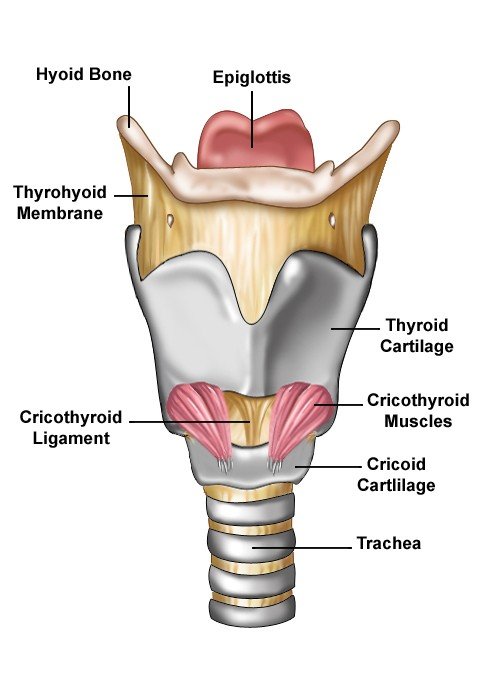4 PHONATION
Making Vocal Sound
Singing is the sound of the the soul stretching
~Mary Chapin Carpenter
HOW VOCAL SOUND IS PRODUCED
Sound is initiated by air passing through the vocal folds in the larynx and then modified in the vocal tract, which consists of the larynx and throat (pharynx) up to the soft palate. The vocal tract link is from the webpage “The Brain from the Top” published by the McGill University and the Canadian Institutes of Health Research. It has fascinating information about the brain and is organized from beginner to advanced.
THE LARYNX
The main purpose of the larynx is to keep foreign matter out of the lungs and for thoracic pressure. Over time, it has been developed into an instrument of wide-ranging expression. You can feel the thyroid cartilage (Adam’s apple) at the front of your neck.
The larynx is made up of four cartilages and a bone:
- Thyroid cartilage
- Cricoid cartilage
- Arytenoid cartilages
- Hyoid bone

Front View of Larynx
As air flows through the larynx, the vocal folds vibrate and sound is modified and amplified in the vocal tract. Changing the position of the larynx affects the shape of the vocal tract, changes voice quality and affects the efficiency of the vocal folds. The cleaner and more efficiently the folds vibrate, the clearer and healthier the sound.
The larynx is suspended and supported in the neck by groups of paired muscles that are in front, behind, above and below. The larynx moves freely when we swallow and speak. It has a complex relationship with the throat, soft palate, tongue, jaw, neck and chest. The position of the neck and chest, movement and tension of the tongue and jaw, and flexibility or constriction of the muscles of the pharynx and neck all contribute to laryngeal efficiency and affect tone quality. This is why we put so much focus on physical alignment in voice training.
MUSCLES OF PHONATION
The vocal folds are layers of muscle, and like all muscles they contract and relax. The primary muscles are thyroarytenoid muscles, which run from the front of the arytenoid cartilages (also called the vocal process) to the inside back of the thyroid cartilage in a pair. To create sound, they adduct (come together). When we breathe, they abduct (open) and create a space, called the glottis. To create higher pitches, they lengthen and become thin; for lower pitches, they relax and thicken.
The arytenoid cartilages can move in several ways. They move the vocal folds apart and aid in stretching. The other set of muscles are the cricothyroid muscles, which attach to the front of the cricoid cartilage and serve to lower the thyroid cartilage, causing the vocal folds to become thinner and longer. The folds then vibrate more quickly, producing higher pitches and lighter tone quality.
Onset (attack) = initiation of tone
When muscles of breathing, airflow and onset are well coordinated, the sound is clear, which is the ideal tone. Too much pressure creates a tense sound or glottal attacks. When folds do not come together efficiently the sound can be breathy.
Follow this link for illustrations and a video of the larynx and vocal folds. You can scroll down and watch a live video of the vocal folds in action. Looking at the Voice
FOCUSED TONE vs TONE PLACEMENT
These two descriptions are often tossed out without understanding or used interchangably. They are two distinct ideas.
A focused tone is the result of efficient vocal-fold vibration that is produced as the folds come together at their full length as air passes through.
- Too much air passing through the vocal folds when speaking or singing will result in a breathy tone. This is different from wind playing.
- Too much sub-glottal air pressure on the folds will result in a pressed or tight tone. The vocal folds should vibrate naturally in response to airflow. Avoid trying to “make” sound happen. This is similar to wind playing.
Tone Placement refers to optimal physical sensations a singer feels when the tone is free and easy. (tone can be “placed” incorrectly, too) Generally, singers should feel “head” sensations above the roof of the mouth and avoid making the tone happen in the mouth and throat. This will result in unwanted tensions. There is a fine balance between encouraging the right tone and forcing it. This balance is achieved through consistent vocal exercise.
Exercises: Phonation
LIP TRILL
Trill or buzz the lips on one tone, then move the pitch up and down. You can sing phrases of songs on a lip trill to help with breath support. If the lip trill is challenging, try saying “brr” as if you are chilled. You can also try a tongue-trill (cat’s purr) or humming if the lip trill is not possible at this time.
Note for high brass players – The lips are much more relaxed than when you buzz your mouthpiece.
SIGH-GLIDE
Sing “ah” from high to low with an easy, consistent tone. This is a controlled sigh, so the air is not pushed out all at once as in a regular sigh. You should not feel tension in the throat. You can also use “wee” and “oo” to achieve an easy, resonant sound. Let this be playful – don’t worry about a beautiful singing tone. The goal is easy and consistent.
PUPPY WHINE
Sometimes too much air is forced out during phonation. Using a minimal amount of energy, whine like a puppy. This should feel easy with a clear tone. After this exercise try singing the whine on a vowel to see if you can achieve the same ease.

